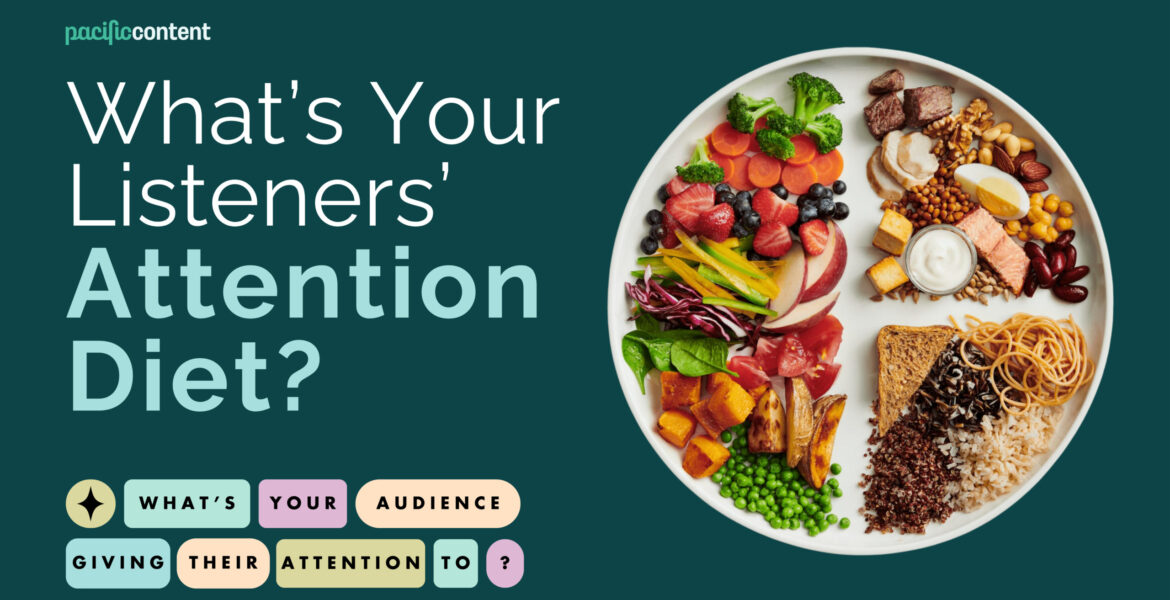What’s Your Listeners’ Attention Diet?

Written by Head of Audience Development Hannah Southern and Head of Podcast Strategy & Development Annalise Nielsen
What’s an ‘Attention Diet’ anyways?
In his recent newsletter, Steve Pratt from The Creativity Business introduced the concept of an “Attention Diet“. Basically, he describes this as a conscious approach to how we spend our limited attention in today’s distraction-filled world. In his newsletter, Steve encourages us to “clean up” our Attention Diets by eliminating distractions (what he calls the “junk food” of attention) and focusing more on the things that truly matter, like writing, creative projects, and time with family.
Steve uses the visual of a plate of food from the food guide to illustrate our Attention Diet–in much the same way that a healthy food diet requires mindful choices to ensure we’re nourishing our bodies, a healthy Attention Diet ensures we’re nourishing our minds.
Using the Attention Diet to Develop Your Podcast
The Attention Diet framework is a great reminder that attention is a finite resource– we only have so much time, and our attention can only be divided in so many ways.
So, it got us thinking about our listeners’ Attention Diets.
One of the first steps to developing a successful podcast for our clients is building a listener profile. We want to know who our listeners are, what their challenges might be, their habits and interests. Any opportunity to better understand our target audience will make the final podcast product better and more successful. During this process, we’ll typically put together a Competitive Landscape Analysis– we identify and review a list of podcasts that our target audience is likely also listening to, particularly those in a similar genre or covering related subject matter. This process helps us understand the other listening options available to the audience, spot potential gaps in the market, and identify common formats or tones for these podcasts. It also helps us make informed decisions about our video strategy– are our listeners consuming podcasts on YouTube? Are they engaging with audio-only shows, or do they prefer full-length video episodes? Do they discover new podcasts through social media, or other platforms?
This analysis enables us to craft a podcast that not only fills a gap but also stands out, while maintaining enough familiarity to capture and hold the attention of our target audience. We can assess the quality of current content– if the landscape is filled with low-quality shows, it presents an opportunity for our podcast to stand out by offering something more polished and valuable.
But why stop at podcasts?
The Attention Diet framework gives us an opportunity to dig even deeper into the overall media habits of our target audience, mapping out where their time and attention are already being spent.
Are they scrolling through Instagram, binge-watching Netflix, or reading newsletters? Do they get their news from cable TV, podcasts, or print? This helps us understand the kind of content that’s already competing for their attention—and gives us insights into how we can create a podcast that stands out.
Where Does Your Podcast Fit Into Your Listeners’ Diet?
Building out our Listener Attention Diet gives us a full picture of what’s competing for our listeners’ attention. What else are they doing instead of tuning into your podcast?

So, now we have begun incorporating a new exercise into our podcast development process with our clients. Combining demographic media consumption research, competitive research, and our clients’ client research, we can brainstorm a complete plate full of attention for our listeners.
Is your audience listening to podcasts while commuting, or do they prefer reading articles at lunch? Are they spending time on social media during their downtime, or do they prefer gaming, streaming services, or other entertainment?
This insight is essential for helping us understand how our podcast can compete for our listeners’ attention. It’s not enough to just create a good podcast—it has to be compelling enough to break through their daily media habits.
With the Attention Diet, we’re creating benchmarks for our podcast: Is it more valuable, more entertaining, easier to consume than something else they’re currently giving their attention to? What will they swap out to spend time with your show?
Using the Listener Attention Diet for Podcast Promotion
The Listener Attention Diet doesn’t just inform the creation of the podcast—it also helps us shape our promotion strategy. By understanding where your audience is spending their time, we can pinpoint the best places to cross-promote the podcast and put our marketing dollars to work.
For instance, if we know your target audience subscribes to specific newsletters, perhaps we look into buying ads in those newsletters. If we know they love certain influencers, maybe it’s worth sending them a PR kit. If they’re subscribers to a print magazine, maybe it’s worth it to pitch them for some earned promotion.
This information helps us think about how to promote your podcast in creative ways that will grab their attention—whether through ads, cross-promotion, earned media, or partnerships.
Putting It All Together: Is Your Podcast Competing for Attention?
The ultimate goal of building a Listener Attention Diet is to understand where your audience’s attention is going and how your podcast can compete for a piece of it. With so many distractions available at our fingertips—from social media to news apps to streaming platforms—capturing your audience’s attention is no easy feat.
By being aware of where your audience is spending their time, we can design content that cuts through the noise and a promotion strategy that targets the right channels. When you understand your listener’s Attention Diet, you can create a podcast that meets (and even exceeds) their expectations.
So, what’s in your listeners’ Attention Diet? And how will your podcast compete for their precious attention?
Sign up for the newsletter for the latest brand storytelling and podcast inspiration, insights, right in your inbox, every two weeks. We promise to never spam you.
